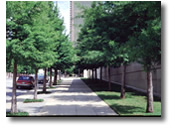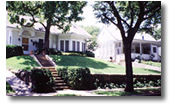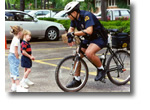  |
|
|
Third Of
A Series By Karen
Walz
Introduction
The first article explained why the U.S. cities that have seen most of their growth since World War II - the 'major postwar cities' - offer the most relevant insights to answer
A Model for Sustainability One measure of a city's success is its sustainability over time - its ability to keep meeting demands of residents and businesses in a way that can be sustained with available resources. Five broad strategies for city sustainability were proposed in the first article of this series:
How do these strategies relate to developed neighborhoods? New housing is built to respond to the perceived market demands of the time, with the neighborhood's design, services and other amenities reflecting the features desired by residents of that era. As demographics, lifestyles and other resident characteristics change, and as the structures age, a neighborhood remains desirable only if it is maintained and if it continues to meet the needs of new residents. Action to maintain neighborhoods' physical assets and reinvest in features that meet new needs is critical if neighborhoods, and the cities where they are located, are to thrive in the future. Cities thatdo not succeed are likely to find themselves surrounded by newer, more appealing communities, thus contributing to urban sprawl. The major
Since change in an existing neighborhood affects many diverse groups, partnerships and coalitions are essential to any successful initiative. Conversely, factions and polarization make an established city a more difficult place in which to develop, encouraging private decision-makers to invest instead in "greenfield" communities where they can complete projects quickly. Many programs discussed below are partnerships among local governments, neighborhood and community organizations, educational institutions and the private sector. This cooperative process is often the key to the results achieved. Every city faces limits to its financial resources and must make choices about its investment in capital improvements. The major postwar cities face a "double whammy" in this regard. Unlike most older major cities, they have areas that are developing now and need extensions of roads, water lines, and public facilities. At the same time, they have developed areas where infrastructure is nearing the end of its projected useful life. The investments made in existing neighborhoods indicate how a city is approaching
One attraction of a new home in a new subdivision is the inclusion of the latest in communications technology. Increasingly, "new urbanism" subdivisions combine these new technologies with more traditional design features such as sidewalks and the location of shopping and services within walking or biking distance. When a potential homeowner is evaluating neighborhoods, the availability of these choices is a factor in deciding where to live. If these choices require a move to a newly developing community, the older cities will be increasingly unable to keep or attract residents. They won't be sustainable because they aren't offering the choices desired by residents who can choose to live almost anywhere. Diversity is a final important consideration. As the 2000 Census data clearly shows, our nation is becoming more ethnically diverse. In addition, fewer households are the typical "nuclear families" with two adults (one working outside the home) and two children. Households with different demographics have different objectives in selecting a home and a neighborhood. Cities that do not offer choices desired by potential residents that are diverse ethnically and demographically will not be sustainable in the long term because they won't be able to provide the housing options desired by these diverse potential residents. The major postwar cities are the "front lines" in addressing diversity and the need for many residential options. Keeping Existing Neighborhoods Vital For this article, the 16 major postwar cities were reviewed to examine the approaches they are using to keep existing neighborhoods renewed and vital. Much of the review was conducted by searching the information found on the cities' internet sites and on linked sites of other organizations. This approach itself is a test of these cities' ability to remain desirable. If these cities are using new technologies to deliver information and services to their existing residents, they are in fact carrying out one aspect of the fourth strategy noted above. For potential residents who can choose to live anywhere, the information available globally on the internet is likely the source of facts and first impressions that will affect the residents' ultimate decisions on where to live. Ten action areas were considered in this review. Each of them relates to the long-term sustainability of developed neighborhoods and communities. They focus on action to maintain, renew, revitalize or transform existing neighborhoods to meet residents' needs now and in the future. Examples from this group of cities show why they are likely to enjoy continuing vitality and success. They suggest initiatives for other cities that also hope to be vital and sustainable 21st century cities. 1. Retaining Historic Neighborhoods Historic preservation is recognized as an important activity in many American cities, and major postwar cities reflect that trend. In addition to designation of historic sites, these cities also commonly designate historic districts, using a valuable tool for preservation of neighborhoods important to a city's heritage. Almost all city web sites included information on the agency operating these programs and making these designations. Charlotte is an example of a city that does more than the basics. Its web site includes photographs, maps and histories of the designated neighborhoods, sharing them with the world. Charlotte citizens clearly support these efforts. In 1991, a successful ballot measure created an Historic Preservation Revolving Fund, administered by the Charlotte-Mecklenburg Historic Landmarks Commission. This $9 million fund is used to purchase, restore and resell endangered historic structures in Charlotte and Mecklenburg County. 2. Maintaining Existing Housing Existing homes, in most cases, are maintained by their owners. The decisions of these individuals play a very basic role in a city's sustainability. As more homes in a neighborhood fall into disrepair - as there are more "broken windows" in the community - safety and other aspects of livability begin to decline. Yet this is an area where governmental agencies cannot act alone; they must work with residents, owners and neighbors to keep
El Paso is typical of many cities in funding a range of housing programs in qualifying neighborhoods through its Community Development Block Grant (CDBG) funds. Other cities, including Austin, offer loan programs for the repair or replacement of single family homes. Austin also operates a Home Maintenance Program to assist low and very low income households in repairing their homes. In Dallas, the city manages "People Helping People," a program that coordinates volunteers who make a variety of home repairs for elderly homeowners who lack the funds or the ability to maintain their own homes. These assistance programs give existing residents and property owners additional resources so their homes (and their neighborhoods) remain livable. Other cities use strategies that make it easier for residents and neighborhood associations to take action. Since many residents find it difficult to obtain city permits and assistance without taking time off from their jobs, San Diego has instituted a "Homeowners Night." A resident reserves time in advance from 5 to 7 p.m. every Thursday evening, and city staff are available to answer questions, process applications and otherwise assist with the steps to repair or remodel a home. In Columbus, neighborhood associations can use the internet to locate the "Neighborhood Pride Columbus" homeowner quiz, a checklist they can use to survey their communities and identify potential problem areas. Phoenix has strengthened its ability to maintain neighborhoods by implementing a clear and detailed code compliance program. Its code includes a "recidivist" provision, directed at property owners who repeatedly violate building and safety codes and refuse to respond to city citations. Individual residents, neighborhood associations, community service agencies and local governments can work together to maintain homes in existing neighborhoods. These tools support such partnerships and help cities stay sustainable by maintaining livable neighborhoods for the future. 3. Investing in Infrastructure Rehabilitation or Maintenance As a city ages, so do its streets, sewer lines, parks and other public infrastructure. Postwar cities are now experiencing the need to rehabilitate or reconstruct, even while they are still struggling to serve newly developing areas within their city limits. All of the reviewed cities include some funding for these projects in their budgets and bond programs. Among the notable and effective approaches to this issue are programs in Houston, Memphis, Jacksonville and Oklahoma City. To implement a new parks master plan, Houston is using a "Parks to Standard" program to fund improvements that bring all existing parks up to their master plan's standards, thus ensuring that residents in existing neighborhoods will enjoy the same level of service as residents in new subdivisions. Similarly, Memphis is undertaking a "playground revitalization" initiative for its neighborhoods. Jacksonville has made infrastructure investment a top priority. Its "Better Jacksonville Plan" resulted in successful passage in September 2000 of a sales tax increase. The additional revenue will fund approximately $2.5 billion in infrastructure improvements. Oklahoma City's MAPs (Metropolitan Area Projects) program has funded a large list of specific revitalization projects in downtown and developed areas. Supported by a temporary 1 cent sales tax, this effort invested almost $360 million from its inception in 1993. The Oklahoma City web site includes an impressive status report of the projects completed through this effort. 4. Nurturing Urban Forests
5. Supporting Compatible Infill Development The major postwar cities were a focal point for rapid development in the 1960's and 1970's. During those years, the fabric of many older neighborhoods was interrupted by garden apartments, commercial uses along now-busy streets and other uses that followed the maxim that more intensity meant better return on investment. Such projects often provided the impetus for creation of politically engaged neighborhood groups. Today, this issue of infill development is a notable part of the postwar cities' balancing act between retaining existing single family neighborhoods and encouraging new development to meet new demands. Compatibility is the key measure in this struggle for sustainability. Many cities use neighborhood plans as a tool to define what is appropriate infill development. Nashville uses a partnership, "Neighbors Planning Neighborhoods," to combine professional expertise and neighborhood involvement. In San Antonio, the city funds neighborhood planning but has limited resources. As a result, there is a competitive process in which neighborhoods compete to receive this assistance. This is a good example of a process with very open decision-making; it probably also encourages the successful neighborhoods to make the most of this assistance and develop a plan they will implement.
6. Providing Community Policing To many suburban residents, the fear of crime is a major reason not to live in their region's central city. If the major postwar cities are to avoid the safety concerns that have had a significant negative impact on older cities, they must offer residents and visitors the perception of safety as well as the reality of a reasonably low crime rate. Virtually all these cities have some form of "community policing" program in place to address this concern. They often focus on neighborhood crimewatch groups, which can monitor safety issues, work with neighbors on preventing crime through urban design, and otherwise extend the reach of the uniformed officers. By involving community residents and business owners in preventing crime, and by creating partnerships where police officers are a part of the community, these programs reduce crime and change perceptions of neighborhood safety. A related initiative is a citizens training program to assist police in monitoring suspicious activity and making reports that are more likely to lead to successful prosecution. These training programs include the VIPs (Volunteers In Patrol) in Dallas, COPS (Citizens Offering Police Support) in Phoenix, and the Citizens Police Academy in Austin. Charlotte is home to the Carolinas Institute for Community Policing, an institute offering classes and programs for uniformed officers and civilians.
7. Making Pedestrian and Greenbelt Connections Greenbelts and other small open spaces are increasingly valued in urban areas as natural amenities and as locations for paths that offer a non-automobile transportation option. Sidewalks, trails and paths are becoming an important connection for walking, biking, skating and other modes of travel and recreation. Many cities are including such areas in their community planning and park system improvements. Cities with larger natural open spaces within their boundaries offer many natural trails - Austin, Phoenix and El Paso are among those with nature preserves or larger "wilderness" parks - but even cities like Columbus have some trails identified within their community. Pedestrian travel in Memphis benefits from the system of parkways (also including automobile routes) designed by Kessler beginning in 1901, while Houston is emphasizing such "linear parks" in its parks plan adopted in 1999. In San Antonio, the greenbelts and natural areas have been managed by an Open Space Board since 1989. These trails and greenbelts offer many advantages to city residents and are increasingly part of the steps these major cities take to provide travel options, recreational choices and areas for enjoyment of nature. 8. Building Neighborhood Leaders and Organizations Neighborhood leaders and organizations are important to the major postwar cities. In researching the role of community partnerships and resident involvement, numerous examples were found, in almost every city, of programs to provide leadership training, technical assistance, public expertise and funding, so that neighborhood groups can play an active role in maintaining the cities' sustainability and appeal. Training and capacity building are important steps for residents who are interested in revitalizing or maintaining their neighborhoods. In Dallas, The Dallas Plan and other organizations sponsored citywide Neighborhood Fairs for several years to create a forum for training and networking among neighborhood leaders. Houston has a major Neighborhood Connections Conference each year, Jacksonville holds an annual Neighborhood Summit, and Los Angeles holds a Neighborhoods
Other resources are found in "toolkits" - resource manuals that provide information on issues ranging from the contents of neighborhood organization bylaws to strategies for affecting zoning cases to fund-raising and neighborhood tours. Many cities have such toolkits, whether produced by the cities or by community organizations. Phoenix offers an on-line version of such a toolkit. In Dallas, the creation of a toolkit was spearheaded by Preservation Dallas, the historic preservation organization, and its production was funded by the private sector. Connections among neighborhood leaders are fostered at conferences, and they are strengthened by tools that enable communication when a neighborhood is dealing with a particular issue. In Fort Worth, the city's web site offers a searchable database of neighborhood organizations with some mapped information as well. Jacksonville has gone a step further in producing a Neighborhood Magazine to share information and contacts among its neighborhood leaders. The value cities place on neighborhood involvement is also evidenced by the emphasis placed on neighborhood issues. Phoenix, Jacksonville and Los Angeles are notable for the support of neighborhoods by their mayors. In Phoenix, the mayor has presented State of the Neighborhoods speeches to representatives of the 676 neighborhood associations in that city. Jacksonville's mayor has designated "Mayor's Intensive Care" and "Sustainable" Neighborhoods as those to which the city provides special assistance and attention. Los Angeles's mayor emphasizes strategies for healthy neighborhoods in the information on his web site. Within the city administrations, neighborhoods are increasingly emphasized as well. Los Angeles' new Department of Neighborhood Empowerment, Phoenix' Neighborhood Services Department, Austin's Office of Neighborhood Services and San Jose's Strong Neighborhoods Initiative are among the examples of city administrative structures that have been reshaped to focus on neighborhood issues. In Jacksonville, a Neighborhood Bill of Rights sets forth the expectations a neighborhood resident or group should have about the city's role and assistance. A major aspect of neighborhood revitalization or maintenance is funding. If there are no funds to repair streets, plant landscaping or carry out other neighborhood projects, it can be very difficult for volunteers from the area to keep their communities thriving. Many of the postwar cities have provided funding for neighborhoods and their initiatives. Some of the interesting examples include Charlotte and Houston, which both offer neighborhood matching grants. In Houston, these grants provide up to $5,000 for "neighborhood rallying projects." San Jose is using part of the proceeds from the tobacco litigation settlement for a Healthy Neighborhoods Venture Fund, which supports education, senior health and other programs within its neighborhoods. San Diego uses a creative approach to provide additional funding for a variety of needs. It has created a "San Diego Donation Fund," which accepts charitable contributions that are used to supplement public funds for improvements in the community. Each month, a specific program is the focus of fund-raising efforts - in March 2001, donations were directed to buying trees to be planted in parks and open space areas. 9. Using New Communications Technology Cities that remain vital over time take advantage of changing technology in all areas. An important aspect of this trend in today's cities is the use of the internet to provide information and to carry out city functions. All the cities in this group have web sites and seem to have major parts of the city codes and ordinances on-line. The complexity and level of detail in these sites varies greatly. One indicator that suggests how closely the web is integrated in the city's efforts to inform and involve citizens is the posting of agendas and minutes from City Council (or comparable elected body) meetings. Each of these cities had the up-coming Council agenda posted on the web; residents can use this technology to learn what issues will be discussed by their elected officials. There is far less consistency, however, in reporting what those elected bodies did. In cities like Austin, Oklahoma City and Nashville, minutes or synopses of action were posted within 2 to 3 weeks of the meeting. Residents of other cities, such as Columbus, El Paso and Fort Worth, must wait 6 months or more to learn of Council action if the web site is their
Similar disparities are evident in other aspects of the cities' use of the web to communicate with their residents. For a number of sites, the principal information available is organized by city department and includes listings of programs and contact names or telephone numbers. While this is useful, far better are the sites, such as those for Phoenix and San Diego, which provide details about program operation, application forms, maps and other information. These sites give an interested resident or business person the actual information about a program, rather than simply a detailed, on-line telephone directory. Again, San Jose is a leader in the use of this technology, with a new system using digital signatures to obtain construction permits on-line. A final notable feature is the extent to which city web sites provide connections to the sites of neighborhood groups or coalitions. Several of these cities are part of Neighborhood Link, a national system of neighborhood sites and related information. Others have partnered with their local newspapers to offer connection to their own neighborhoods' web sites. Fort Worth maintains an on-line system for communicating with neighborhoods through its LiNC to Neighborhoods and in Austin, the Metropolitan Austin Interactive Network's Community Registry notes over 400 organizations. These examples demonstrate that new technology for communication is a clear component of the major postwar cities' efforts to communicate with their residents and other interested persons or groups. This communication, and the resources it makes available, provides existing residents with tools to take action in their neighborhoods. They help inform and invite a potential new resident as well. 10. Exploring Other "Smart Growth" Approaches A final area for review is in the concept currently termed "smart growth." This planning and design approach uses a range of policies and programs to support continuing growth but in a way that is sustainable and of high quality. A detailed comparison of "smart growth" programs in these cities is beyond the scope of this article. However, it is notable that many of them are using this concept as a way to direct their city's plans, policies and development regulations. Several cities, including Austin and Charlotte, have developed a set of indicators to use in measuring residents' quality of life, an important aspect of the smart growth concept (in both these cases, many indicators relate to the region rather than just the major city). Quality of life is also the focus of periodic citizen surveys in San Diego, Charlotte and Phoenix, among others. Plans and ordinances implementing "smart growth" are now being developed or have been adopted fairly recently, so it is too early to determine whether they actually have changed the shape or quality of these cities' growth. Among the interesting examples of smart growth plans are those underway now (as updates to general plans) in Charlotte, Jacksonville and San Diego. Dallas is reviewing the use of these techniques as part of its continuing implementation of The Dallas Plan. Austin has approved a Traditional Neighborhoods Ordinance, making this an option available to developers that wish to use smart growth concepts and the urban design features of "new urbanism" to create new livable neighborhoods. Phoenix has had an option for "infill housing" available since 1995, providing fee waivers and infrastructure assistance to projects in designated areas within the developed city. Conclusion The strategies noted at the beginning of this article are in use today in the major postwar cities of the U.S. They are directly related to the approaches these cities are taking to their existing neighborhoods. The specific programs and partnerships described above give other cities many examples of successful initiatives that keep cities livable and sustainable. They use the best of traditional design and new technology, empower community residents while investing public resources and expertise, and embrace their communities' natural and historic resources. In these ways, these major cities show their determination to continue among the most livable cities of the 21st century. Next In Livable Cities of the 21st Century The fourth article in this series will examine economic and business forces at work in these major postwar cities and will identify the strategies these cities are using to keep their businesses and economies strong. The series will conclude with an evaluation of the techniques used as these cities address newly developing areas. Karen
S. Walz is the Principal in Strategic Community Solutions (SCS)
and the Executive Director of The Dallas Plan, a non-profit organization
created to work with the city of Dallas and the Dallas community to
create and implement a long range plan. Prior to forming SCS, Walz was
Director of Planning for Freilich, Leitner and Carlisle, managing planning
projects for clients nationwide. She has also served as the Manager
of Comprehensive Planning for the City of Austin and as Special Assistant
for Economic Policy at the Boston Redevelopment Authority. |
||||||||||
|
Home | History & Archive | Video Productions & Services © Copyright 1998-2023 EcoIQ
|













 s
we begin the 21st century, it is clear that emerging technologies and
changes in the economy will have a significant impact on the shape of
our urban areas. At the same time, the long-term viability of these
areas will depend on the locational choices made by millions of individuals
and businesses, choices that will be based on the same question as in
past centuries - is this city a good place to live and conduct business?
This series of articles explores the factors that help answer that question.
s
we begin the 21st century, it is clear that emerging technologies and
changes in the economy will have a significant impact on the shape of
our urban areas. At the same time, the long-term viability of these
areas will depend on the locational choices made by millions of individuals
and businesses, choices that will be based on the same question as in
past centuries - is this city a good place to live and conduct business?
This series of articles explores the factors that help answer that question. Natural
resources can be important assets for a city, providing recreational
areas, storm water retention and filtration, air quality improvements,
tourism and, importantly, a healthy environment for a sustainable community.
In some cities, urban forests have been an asset for many years. Fort
Worth celebrates the fact that it has had an urban forestry program
since 1928, even as today's city offers free trees for neighborhood
groups to plant in parkways and medians. Columbus is one of several
cities that uses a "Keep Our City Beautiful" partnership to
maintain and enhance open spaces. Jacksonville's initiative, "Clean
It Up, Green It Up" combines traditional beautification with planting
efforts. The goal, as expressed well by the Parks Director of Memphis,
is "not only to build parks within the city, but to build a city
within a park." This is an eloquent expression of a key tenet of
sustainability and 21st century livability.
Natural
resources can be important assets for a city, providing recreational
areas, storm water retention and filtration, air quality improvements,
tourism and, importantly, a healthy environment for a sustainable community.
In some cities, urban forests have been an asset for many years. Fort
Worth celebrates the fact that it has had an urban forestry program
since 1928, even as today's city offers free trees for neighborhood
groups to plant in parkways and medians. Columbus is one of several
cities that uses a "Keep Our City Beautiful" partnership to
maintain and enhance open spaces. Jacksonville's initiative, "Clean
It Up, Green It Up" combines traditional beautification with planting
efforts. The goal, as expressed well by the Parks Director of Memphis,
is "not only to build parks within the city, but to build a city
within a park." This is an eloquent expression of a key tenet of
sustainability and 21st century livability. These
plans can be utilized in the larger framework of city policy as well.
Phoenix and San Diego use the concept of "urban villages"
as part of their overall city development plans. Jacksonville is developing
an updated comprehensive plan now that will include special infill incentives
for designated areas. Dallas is one of the major cities that has defined
"compatibility standards" in its zoning ordinance for use
in projects adjacent to existing neighborhoods.
These
plans can be utilized in the larger framework of city policy as well.
Phoenix and San Diego use the concept of "urban villages"
as part of their overall city development plans. Jacksonville is developing
an updated comprehensive plan now that will include special infill incentives
for designated areas. Dallas is one of the major cities that has defined
"compatibility standards" in its zoning ordinance for use
in projects adjacent to existing neighborhoods. Among
the many policing initiatives in these major postwar cities, a few stand
out. In Fort Worth, voters approved a special tax for a Crime Control
and Prevention District in 1995 and reauthorized the district in 2000.
The district's funds (almost $36 million in Fiscal Year 2000-2001) are
used for staffing, training, technology and many other aspects of crime
prevention in Fort Worth neighborhoods. Charlotte helps residents combat
crime by providing information. Their statistics on criminal activity
are mapped using a Geographic Information System (GIS) and are posted
on the city web site.
Among
the many policing initiatives in these major postwar cities, a few stand
out. In Fort Worth, voters approved a special tax for a Crime Control
and Prevention District in 1995 and reauthorized the district in 2000.
The district's funds (almost $36 million in Fiscal Year 2000-2001) are
used for staffing, training, technology and many other aspects of crime
prevention in Fort Worth neighborhoods. Charlotte helps residents combat
crime by providing information. Their statistics on criminal activity
are mapped using a Geographic Information System (GIS) and are posted
on the city web site. 